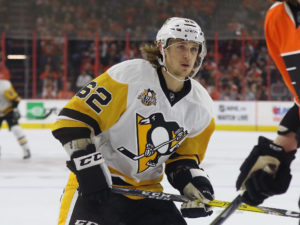The All-Star break is a good time for players to get a respite from the intense schedule of the season, and it’s a good time for fans to watch the NHL’s favorites make awkward small talk amongst themselves.
It’s also a good time to look back and evaluate how a team has changed over the past year. As an event that takes place at about the halfway mark of the season, the All-Star break serves as a good benchmark for how a team’s doing. At last year’s All-Star break, the Pittsburgh Penguins weren’t even sure that they’d make the playoffs. Now, one year later and one Stanley Cup richer, the team is gearing up for the second half of what will hopefully be a more consistent season. How far have they come since the 2016 All-Star break, and what’s changed?
Changes by the Stats
Coming out of last year’s All-Star break, the Penguins were ranked 16th in the league with 55 points. They had a record of 25-16-7, almost exactly even in their wins to losses ratio at 25:23.

This year, the Penguins are coming out of the break as the fourth best team in the league. They have 65 points and a record of 30-13-5.
They’re coming out of this break with better stats in almost every area from what they were one year ago, including a better power play (from 19.9 success rate and 10th in the league one year ago to 22.8 success rate and fifth in the league today).
The area that they’ve declined most sharply in is their penalty kill. One year ago, it was ranked seventh in the league; it’s now ranked 24th. The Penguins dropped from a penalty kill in the top third of the league to one in the bottom third. Their success rate in preventing the other team from scoring when they’re down a man has dropped from 83.8 percent a year ago to an average of 78.9 percent.
A Summary of Roster Changes

One year ago, the Penguins roster was adapting to some recent additions that came with Mike Sullivan’s midseason arrival in Pittsburgh. For instance, the 2016 All-Star break came shortly after Conor Sheary and Tom Kunhackl were called up to the NHL for the first time. Other recent additions had been Trevor Daley, who joined the team in exchange for Rob Scuderi about a month before the break, and Carl Hagelin, who the Penguins received for David Perron and Adam Clendening two weeks later. These new additions to the roster would end up being crucial to the Penguins’ successful playoff run.
The most notable loss from the Penguins roster as it looked at the time of the 2016 All-Star break is Ben Lovejoy, who the Penguins failed to re-sign to the team after he played a full 24-game playoff run with them. Instead this year, the Penguins have added a few new names to the list. Justin Schultz, acquired from the Oilers late last season, is one of them. Jake Guentzel is another notable addition as a young forward who’s been holding his own in the Penguins’ lineup. Yes, he’s a just a call-up to replace some injuries in the Penguins lineup; but then again, one year ago, so was Sheary.
The Impact of Roster Shakeups
Overall, the current Penguins roster is a list of names very similar to the one we saw coming out of last year’s All-Star break. What has changed, however, is the role that these players fill within the team. Here are some of the biggest changes within the Penguins roster that will be coming out of the 2017 All-Star break as opposed to the one that we saw after the 2016 break.
1. Sheary and Bryan Rust, who were both serving minor roles on the roster one year ago, are now playing on the Penguins’ top line.

2. Derrick Pouliot, who at the time of the 2016 All-Star break was beginning what would end up being a two-month stretch of playing time in the NHL, would never prove to become the asset the Penguins were hoping he would be. He ended up spending his next season (barring a brief call-up) still in the minors.
3. Schultz, the defenseman acquired by the Penguins later in the 2015-16 season, put up an underwhelming performance in his first run with the Penguins. But this season, he’s been a crucial part of the team’s success. Schultz has been one of the Penguins’ highest producing defensemen going into this break as he’s stepped up in the absence of the injured Kris Letang.
4. And in perhaps the most surprising coup on the roster, Murray — who played his first NHL game in December 2015, just about one year ago — is now operating as the Penguins’ No. 1 goaltender. Marc-Andre Fleury, the unquestioned starter at this time one year ago, has been relegated to serve as backup.
Learning from the Changes
The All-Star break is a good time to look back and reflect on the team and how they’ve changed. Much of the change is positive. The Penguins are one of the top teams in the league, with line combinations that are overall clicking better than they were one year ago.
However, the Penguins are in a division that’s easily the most competitive in the NHL this season. Even sitting fourth in the league, the Penguins are only third in their division. They need to eye the stats that they’ve worsened in, like their struggling penalty kill. And they need to learn from the lineup changes of last year by depending on call-up defenders, other than Pouliot, and keeping Sheary and Murray central to the lineup.